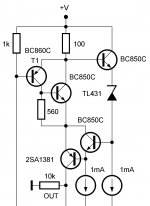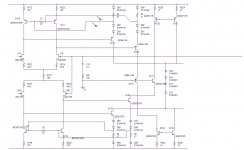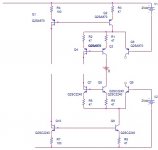Sorry to realize that you dont like the control loop. But that can bee deletet...
cheers
Ronny
Hi Ronny,
Nothing wrong with a CMCL, but I rather prefer an apples to apples comparison (thus without using a CMCL).
In this respect the circuit you have put here would have been more appropriate. But again, THD20K of that circuit is much more higher. Probably, (partly) due to the local feedback via R89 and R91. However, when I disabled the local feedback, the VASes start a fierce fight, resulting in an enormous distortion. Apparently it's caused by unequal gains of the LTPs (or VASes?). With C9 = 85pF and C10 = 115pF the fighting has almost gone. It also has gone when I replaced the Miller compensation by an 'input inclusive compensation' (by means of only one capacitor, though in that case you also need extra lead-lag compensations between the drains of the jfets).
BTW, are you sure your latest schematic is correct? It doesn't work according my simulation (I got a huge distortion; fighting VASes again?).
Cheers,
E.
Last edited:
[..]
Not so sure I understand some similar issues on your website.
In Fig 1a to 1c. the TIS is shown as Ai=-10k.
Since it's a TIS should it not be defined by its impedance?
Minor proof corrections. In the "OMC versus TPC versus TMC" section you have drawn a 4 stage model but the text assumes only 3. Better to say that TPC benefits all stages while TMC does not help the IPS. Also you define CMC as Conventional Miller Compensation but use the abbreviation of OMC (Ordinary Miller Compensation I expect). OMC is better since CMC looks too like CMCL.
Best Wishes and more comments to follow!
David
Done!
Cheers,
E.
Two years ago, the same guy analyzed and measured a bootstraped Baxandall pair version, on the now defunct diy-audio-engineering forum (sorry, I don't have the permission to post the schematic). The VAS distortions were also vanishing low (even lower than what Edmond is showing here), but here it's Edmond's output stage that allows going into the ppm range. Without the autobias output stage, the results are not hugely better than a standard Blameless. That's because the standard EF output stage distortions are orders of magnitude larger than the VAS, anyway.
That's right; (as you might remember) we compared different cascode circuits.
This is a comparison between a Hawksford / Baxandall cascode and a bootstrapped Hawksford / Baxandall cascode.
As you can see in the first pdf the Hawksford / Baxandall cascode oscillated (at about 20MHz), I had to put in a resistor to tame the oscillation. (Second pdf)
As you can see from the comparison between the two (third pdf), the bootstrapped cascode has a lot lower distortion products.
Cheers
Stein
Attachments
That's right; (as you might remember) we compared different cascode circuits.
This is a comparison between a Hawksford / Baxandall cascode and a bootstrapped Hawksford / Baxandall cascode.
As you can see in the first pdf the Hawksford / Baxandall cascode oscillated (at about 20MHz), I had to put in a resistor to tame the oscillation. (Second pdf)
As you can see from the comparison between the two (third pdf), the bootstrapped cascode has a lot lower distortion products.
Cheers
Stein
Hi Stein,
Thx for the additional info. I wasn't aware of syn08's sims of the Baxandall VAS, as I requested Andy to annihilate my membership of the diy-audio-engineering forum (for obvious reasons!).
There's one thing I really don't understand. Regarding pdf no. 1, right schematic. This one oscillates at 20MHz, while the left schematic does not oscillates, right?
So, for heavens sake, why has the base current of the 'helper' trannies (Q18 & Q18) also been recycled?! A double recycling to squeeze out the last ppt of distortion? 🙄
Regarding the left schematic, what are the EF followers Q9 & Q10 good for? Why not simply tie bases of the 'helper' trannies to a fixed voltage, as is done in the SuperTIS?
Cheers,
E.
That's right; (as you might remember) we compared different cascode circuits.
This is a comparison between a Hawksford / Baxandall cascode and a bootstrapped Hawksford / Baxandall cascode.
As you can see in the first pdf the Hawksford / Baxandall cascode oscillated (at about 20MHz), I had to put in a resistor to tame the oscillation. (Second pdf)
As you can see from the comparison between the two (third pdf), the bootstrapped cascode has a lot lower distortion products.
Cheers
Stein
Hi Stein 😉
Finally VAS-transconductance stage treated as deserves it. Very much like bootstrapped cascodes, will test and implement in next amp.

BTW, is this your idea or it was patented already or else? 🙄

Attachments
Finally?🙄
Not with upper, but this one makes T1 to feel like on
 😀
😀Attachments
Hi Edmund thanks for not humilliating me.Hi Ronny,
Please, show us how to do that without degrading the gain of the LTP-VAS combo (and without using a CMCL, of course).
See this comment for a numerical example.
Cheers,
E.
I see the problem about current fighting, and oscillating loops when too long.
Splitting them and the feedback makes the resistor values S1 and S2 interesting in circuit perspective.
Attachments
Hi Edmond thanks for not humiliating me.
[..]
I'm not always such a nasty fellow. 😉
Cheers,
E.
RFI
Hi Bob,
As for the SuperTIS, 'its graphical symmetry [not just] looks cool', but it also performs very cool. 😎
Putting JFETs in the input stage (in case of this front-end), is the worst thing one can do. So, the fact that complementary P-channel and N-channel dual JFETs are hard to get (not to say unobtainable) is rather a bless than a curse.
I've just complemented my website (at the bottom) with distortion and RFI sims of a few front-ends with a BJT respectively a JFET input stage.
I'm sure you will like it. 😉
Cheers,
E.
[..]
I agree with your concerns about re-introducing the VAS-VAS fighting issue when using a complementary double VAS. I have never been convenced, at the end of the day, that a fully complementary IPS-VAS was superior to a push-pull VAS using a unipolar input stage (see, for example Figures 7.14 and 7.15, or Tom Holman's APT power amplifier).
To me, the value-added of the full-complementary IPS-VAS is that it is just a convenient way to achieve and drive a push-pull VAS. The main benefit lies in using a push-pull VAS, and the complementary IPS is just one way to achieve that. Its graphical symmetry also looks cool on the schematic, however. Its big disadvantage is that with virtually all such arrangements, you must have P-channel and N-channel dual JFETs if you insist on having a JFET input stage (which is what I always prefer). Note, however, my approximation to the complementary goal using only N-channel JFETs shown on page 143.
Cheers,
Bob
Hi Bob,
As for the SuperTIS, 'its graphical symmetry [not just] looks cool', but it also performs very cool. 😎
Putting JFETs in the input stage (in case of this front-end), is the worst thing one can do. So, the fact that complementary P-channel and N-channel dual JFETs are hard to get (not to say unobtainable) is rather a bless than a curse.
I've just complemented my website (at the bottom) with distortion and RFI sims of a few front-ends with a BJT respectively a JFET input stage.
I'm sure you will like it. 😉
Cheers,
E.
I get an AVG security active threat warning from your link and am prohibited from opening it. Anybody else?
Brian.
Brian.
Hi Brian,
I'm also using AVG (BTW, certainly not the best anti virus S/W), nevertheless no warnings from my own website.
edit: Try to use this url instead: http://home.tiscali.nl/data.odyssey/index.html
or this one: http://www.data-odyssey.nl/
Cheers,
E.
I'm also using AVG (BTW, certainly not the best anti virus S/W), nevertheless no warnings from my own website.
edit: Try to use this url instead: http://home.tiscali.nl/data.odyssey/index.html
or this one: http://www.data-odyssey.nl/
Cheers,
E.
Last edited:
You're welcome!
edit: What about another virus scanner? I'm through with AVG.
Use MS security essentials and Malwarebytes
I never understood the virus craze. I never got viruses, not one, even while using windows unprotected. It was this way with windows 98 and 2000, by the time I used XP I had Avast though. The first time I installed antivirus I scanned and it said it didn't find anything. I never understood why. Since then I moved to Linux. On Linux viruses don't seem to exist.
virus scanners
Hi Kris,
Does MS security essentials work under any copy of (a copy of) XP?
BTW, I advised my GF to use that too!
Cheers,
E.
Use MS security essentials and Malwarebytes
Hi Kris,
Does MS security essentials work under any copy of (a copy of) XP?
BTW, I advised my GF to use that too!
Cheers,
E.
I never understood the virus craze. I never got viruses, not one, even while using windows unprotected. It was this way with windows 98 and 2000, by the time I used XP I had Avast though. The first time I installed antivirus I scanned and it said it didn't find anything. I never understood why. Since then I moved to Linux. On Linux viruses don't seem to exist.
Hi Keane,
[OT]
I never surf porno sites or equal dangerous places. Despite of that, I got a Trojan horse last month,which sneakingly redirected my PC when logging into my bank account. Very dangerous! On top of that, this virus was not detected by AVG.

Happily my bank provides a dedicated virus scanner to kill those horses.
[/OT]
Cheers,
E.
I could have written much the same post yesterday. I started using several of the free antivirus programs on WIN2K around 2001 or 2002 when we graduated to DSL and we (myself, wife & 2 teens) started to use the internet for more than daily email runs. Every month or two it would trigger on something. When I bought a brand new WIN7 machine over 2 years ago I added a paid copy of Avira to the purchase, mostly "just because".. . . I never got viruses, not one, even while using windows unprotected. . . .
Then, in the last 24 hours, I put in almost 10 hours fighting the "SMART Check HDD" rogue. I'm fairly confident that the virus itself, and its droppings, are gone but I have not yet finished repairing the damage. It managed to slip past my paid version of "Avira" - in fact, it seems to have damaged or corrupted Avira and I reverted to a prior version. Based on posts left on various computer security forums in the last month or so, there are quite a few victims with similar stories.
The really insidious thing about this infection is that has a very genuine "look and feel" to it. The spelling, grammar, language style, and visual appearance are very convincing. My wife was almost ready to "purchase" a "software repair tool" when I did a little research with the antique computer (WIN2K on an Athlon 800, circa 2001). It appears that the credit card information would have disappeared into a bogus IP address somewhere in central Asia . . .
Don't yet know what all the "lessons learned" are. I'm thinking about a statement supposedly from Sir Winston Churchill, after the battle of Omdurman: "There is nothing quite so exhilarating as being shot at, and missed."
Dale
- Status
- Not open for further replies.
- Home
- Amplifiers
- Solid State
- Has anyone seen this front-end before?
![Cascodes%202[1].jpg](/community/data/attachments/267/267882-18f12bed67656b8d7446245ac1b28cff.jpg?hash=GPEr7Wdla4)
![Cascodes%203[1].jpg](/community/data/attachments/267/267923-f006156a389e68eb20d0772188299ba2.jpg?hash=8AYVajieaO)


